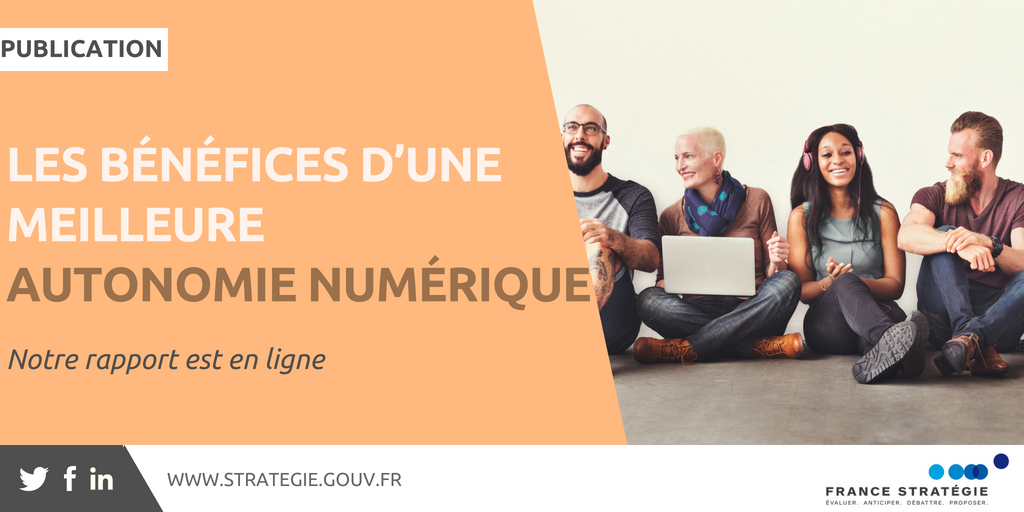 In France, 14 million people are not Internet users. The vast majority of them have little or no access to digital tools. This prevents these people, a fortiori, from enjoying the benefits generated by a controlled use of the Internet.
In France, 14 million people are not Internet users. The vast majority of them have little or no access to digital tools. This prevents these people, a fortiori, from enjoying the benefits generated by a controlled use of the Internet.What could these benefits be? How can they be evaluated? These are the questions that this report seeks to answer. The report was commissioned by Mounir Mahjoubi, the French Secretary of State for the Digital Economy, in the context of the upcoming implementation of the "national strategy for an inclusive digital economy" led by the Mission Société Numérique.
Download the report:
http://www.strategie.gouv.fr/sites/strategie.gouv.fr/files/atoms/files/fs-rapport-benefices_autonomie_numerique-12072018_0.pdf
This report seeks to identify and quantify the benefits of improving digital literacy for the portion of the French population that does not use digital tools in everyday life. It quantifies only the benefits of greater digital autonomy and not the costs of implementing a strategy to achieve this goal. The focus here is on the net effects, taking into account the fact that only a portion of individuals who have been initiated to a basic use of digital technology would ultimately decide to use it in everyday life. It is not a question of measuring the benefits of advanced digital training, nor the consequences of major changes in uses and methods in the workplace, at school or in other places of socialization. We focus on measuring the effects of support for the simplest uses of the Internet, leaving to other works the issues related to the changes in society that artificial intelligence, the Internet of Things, mass data, and industry 4.0 could bring about.
In a world where the digital interface is becoming more and more frequent for the simplest operations of everyday life, the lack of mastery of this means of communication can lead to a risk of exclusion for the populations concerned. There are two main categories of people who are far from the digital world: "non-users", who never connect to the Internet, and "remote" Internet users, whose digital skills are so weak that they cannot perform certain simple operations. Thus, remote Internet users are only very rarely able to exploit the potential of the Internet in their online administrative procedures, online purchases, or the development of their personal social network via digital tools.
In total, people who are far from the digital world represent 28% of the French population over the age of 18, i.e. around 14 million people. Unsurprisingly, there is a significant correlation between age, on the one hand, and socio-professional category, on the other hand, and the lack of digital autonomy: the older people are, the less they use or master the Internet. Furthermore, blue-collar workers, people without a job and retirees, and people with the fewest diplomas and the lowest incomes are over-represented among those who are far from the digital world. The benefits of greater digital autonomy are mainly related to four main areas. For each of these areas, the study seeks to estimate the benefits to be expected by identifying the key parameters of the calculation in the economic literature. Quantitative results are presented here for each of the major domains, assuming the deployment of a digital inclusion strategy aimed at supporting one third of the target population over ten years. As not every individual is affected by all four domains, the target population is defined specifically for each of them. Details of the calculations used to define the target populations and the benefits attached to each of the domains are given in the body of the report, together with the references of the studies that enabled the key parameters to be identified.
The first area is the digital economy, which includes online shopping and the collaborative economy. The development of the online purchasing capabilities of one third of the target population could generate annual gains in purchasing power of around 60 million euros. The development of the use of collaborative economy platforms could generate annual gains in purchasing power of around €270 million if one third of the target population were supported in the use of digital technology.The second area is employment and training.Available studies indicate that Internet use has a positive impact on academic success, even when correcting for biases related to the economic and social background of students. A policy of digital inclusion of high school and university students could thus, in the long run, significantly raise the overall level of qualification of the French population. Within the framework of a ten-year plan to train and support one third of the target population, i.e. 300,000 students, in digital uses, it is estimated that a little more than 20,000 students could take advantage of these skills to improve their academic performance and obtain a better diploma at the end of their studies. The average annual gain from increased educational attainment would then be in the order of €10 million. 120 million per year if one third of the target population was supported in the use of digital technology. Studies show that training and support in the use of digital tools help to reduce the risk of unemployment and increase the chances of finding a job. If one third of the target population were to benefit from a good command of digital technology, the gains linked to the reduction of structural unemployment could be of the order of 100 million euros per year in purchasing power for the unemployed. The savings for the public administration due to the reduction of social transfers could be of the same magnitude. 180 million for the unemployed and the same amount for the public administration, if one third of the target population were supported in their transition to digital technology.The third area where the benefits of digital inclusion can materialize is in the relationship with public services. The possibility of carrying out a certain number of administrative procedures online, rather than in a physical reception area or by telephone, is a powerful source of savings for the administration and benefits for the users of public services. The estimated gain for the public service thanks to a digital inclusion plan reaching one third of the target population and allowing for increased use of online procedures would be 150 million euros per year. This amount could finance a better reception and support for the public who really need it. 50 million per year if one third of the target population were supported in the use of digital technology.Finally, the fourth area is social inclusion and well-being. Through e-health, the use of the Internet improves access to care as well as its quality and efficiency. Assuming that access to digital technology avoids one consultation per year with a general practitioner, the potential savings could reach 10 million euros for patients and more than 20 million euros for the health insurance system in a plan reaching one third of the target population. The acquisition of basic digital skills also allows individuals to save a substantial amount of time by using dedicated digital services, such as online banking or paperless administrative procedures. The annual time saving after a digital training or support could represent around 200 million euros for a third of the target population. Through the use of social networks and instant messaging, the acquisition of these skills should also contribute to an improvement in the social capital of users, i.e. the number and quality of contacts maintained. 1.4 million individuals could benefit from an improvement in their social capital if they had a better command of basic digital skills. If one third of this target population were supported in the use of digital technology, the gain would be 50 million euros. This report does not ignore the risks of addiction and certain practices that are harmful to the development of minors on the Internet, but it starts from the principle that Internet access for children and teenagers must be under the control of parents and during limited hours.In total, if we add up the different gains apart from the improvement of social capital, a digital inclusion plan that would reach one third of the target population over ten years, i.e. about 4.7 million people who are far from digital, could represent a gain of 1.4 billion euros per yearon average over this period. This gain should be set against the cost of the plan itself, which the work presented in this report does not attempt to quantify. The estimation of the monetary benefits of an inclusion strategy leads to very significant results, but in total, they are not enough to change the country's growth path. This confirms that digital inclusion is first and foremost a matter of equity, equal rights and social cohesion.





